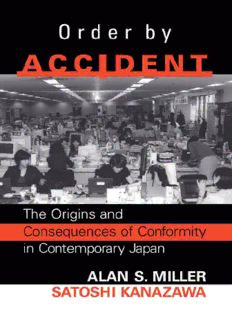
Order by Accident: The Origins and Consequences of Conformity in Contemporary Japan PDF
Preview Order by Accident: The Origins and Consequences of Conformity in Contemporary Japan
Order by Accident This page intentionally left blank Order by Accident The Origins and Consequences of Conformity in Contemporary Alan S. Miller Satoshi Kanazawa , A Member of the Perseus Books Cixaup All righl-s reserved. PrinQd in the United States of America. No part of tl~ips ublication may be reproduced or transmitted in any form ar by any means, electronic or mecl~anical,i n- cluding phokow"~,~ cclrdingo, r any informatior-r storage and retrieval system wit.l~out permission in wri-iting from tl-re publisher. Crjpyright O 241CNl by Westview Press, A Member of the Perseus Books Group hblisl~edin 2W0 in the United States of girnerica bp West-iiiew Press, 5500 Central Avenue, Boulder, Colorado 90301-287'7, and in the United Kingdom bp Westview Press, 12 Hid's Copse Road, Cumor Hill, 0xfol.b OX2 9JJ Find us on the Wt?rId Wide Web at ww~~.westviewpirt3ssScom Library of Crjngress Cataloging-in-Publicat.ion Data A CIP catatog record for tl~ibs ook is avail&le from the Library of Crjngress. lSDN 0-8133-3921-9 The gaper used ir-r this publication meets the requirements of t11e American National Stan- dard for Permanence of Paper for PI-inteQ Library Materials Z39.48-19%. This book is dedicated to my parents, Joscph and Thelmn Miller, wllo never discoclraged me fvom pursuing my interests, even though, in retrospect, they aften should have.-A.S.M. To Michael Hechter, without wl~um I would not be intevested in japan in the slightest.-S.K. This page intentionally left blank Contents List of T~bleas nd iciyzres Achtowledpen ls Part One: Theoretical Orientation 1 Social Order md Social Co~~troAln: Introduction Ironies of Social Structure, 4 Social Order, 5 Informal Social Control, B The Organization of the Book, 11 2 The SsZidaristic: Theory of Social Order Wow Social Qrder Emerges as an Unilltmded Consequence of Croup Solidarity, 14 Wow Groups Produce Solidarity, 16 Conclusion, 19 Part Two: Social Xnstittxlions 3 The Education System: Social Irlitiation Depedcrxnce md NormaGve Obligations, 24 Visibility, Monitoring, and Sanctioning, 34 Conclusio~3~7, 4 Work: A Continuation Bpendence cvld Normati:vc (17bligations, 40 Visibility, Monitoring, and Sanctioning, 46 Conclusio~4~9, 5 The Family Division of Labor, 51 Family Patterns, 56 Relationship ta Social Control, 58 Conclusio~5~9, 6 Crime Theories of Crime, 63 The Japanese Social Stucturcl and Its Relationship to Crhe, 68 Conclusio~7~7, Part Three: Nonintuitive Consequences 7 Crime Revisited: White-Collar Crimes Refinfng Our Concept of Mlhite-CotZar Crime, 82 Companies as Subcultt~res8, 5 Examples of Whitcl-Collar Crbe in Japan, tS8 Conclusion, 91 8 The Religious LJmdseape of Japan Religion in Japan,9 3 The Japmese Social Strudure and Its Impact on Religion, 98 Empirical Support, 100 Conclusio~1~0, 3 9 Trust Are Japanese Gmup-Oriented? 105 Generalized Trust, 107' kdefjning a Culture of Collectivism, 114 Conclusion, 116 Part Four: Speculations and Conclusions 10 The Emergmee of Cooperatiw Social Institutions MatA re Cooperative Social Institutions? 121. How Do Cooperative Social hstitutions Emerge? 124 I-low Did the Unique Coopmathe I~~stituths Emerge Chly in Japan? 129 Conclusion, 231 11 Conclusion Tables and Figures Tables 11 Total nurnber of Nobel Prizes wo11 (afnmgh 1995) 1.2 Hmicide rate per 100,000 populatjon 3.1 Juvenile suspects per 180,000 population 3.2 Petaent of students who studied in after-school programs while in elementary school and junior high school 4.1 .A cornparism of annual working hours, 1995 42 A comparison of lahor productivity 1994 5.1 Mothers' attitudes toward their sons md daughters 5.2 Attitudes toward traditional gender roles 5.3 Japanese at;litudes toward a gende~hasedd ivision of )ahor 6.1 Cross-national crime rates per 100,000 population 6.2 Uncmployxn,ent rates for the United States, United Kingdom, and Japan, 196&1998 6.3 Percent of eportclld homicides and assaults cleared by arrest 6.4 %verity of sentencing practicrs 7,1 Cross-nationai comparison of fraud and embezzfement rates 72 hternational comparison of perceived corruption 7.3 Pet~enwt ho must be convinced before fnlIowing questionable orders 7,4 H w m uch control do you have over yow own life (0-1U)T ""yes 8.1 Percent answering typical religion wstions 8.2 Percent answerhg ""yes" to other questions on religiosity 8.3 The relationship between job involvement and religiosiw 8.4 The ~lationshipb etwen social suppcrrt and affiliation in New Religions 9,1 A Japan-U.S. comparison of generatized tmst
Description: